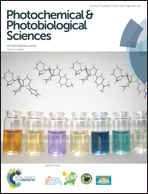Effect of torsional isomerization and inclusion complex formation with cucurbit[7]uril on the fluorescence of 6-methoxy-1-methylquinolinium†
Abstract
Inclusion of 6-methoxy-1-methylquinolinium (C1MQ) in the cavity of cucurbit[7]uril (CB7) was studied by absorption, fluorescence, NMR and isothermal calorimetric methods in aqueous solution at 298 K. The free C1MQ exhibited dual-exponential fluorescence decay kinetics due to the two torsional isomers differing in the orientation of the methoxy moiety relative to the heterocyclic ring. The enthalpy-driven encapsulation of the heterocycle in CB7 led to a very stable 1 : 1 complex with a binding constant of (2.0 ± 0.4) × 106 M−1. The rate of C1MQ–CB7 complex dissociation was found to be comparable to the NMR timescale. Because the methoxy moiety is oriented outward from the host, its s-cis–s-trans isomerization is slightly affected by the confinement. Inclusion complex formation significantly slowed down the photoinduced electron transfer from I− and N3− to the singlet-excited C1MQ, but did not preclude the reaction because long distance electron transfer occurred through the wall of the CB7 macrocycle. Due to the large difference in the quenching rate constant for free and encapsulated forms, C1MQ is an excellent probe for the study of the inclusion of nonfluorescent compounds in CB7 in the presence of Cl− or Br−.
![Graphical abstract: Effect of torsional isomerization and inclusion complex formation with cucurbit[7]uril on the fluorescence of 6-methoxy-1-methylquinolinium](/en/Image/Get?imageInfo.ImageType=GA&imageInfo.ImageIdentifier.ManuscriptID=C3PP50307K&imageInfo.ImageIdentifier.Year=2014)

 Please wait while we load your content...
Please wait while we load your content...